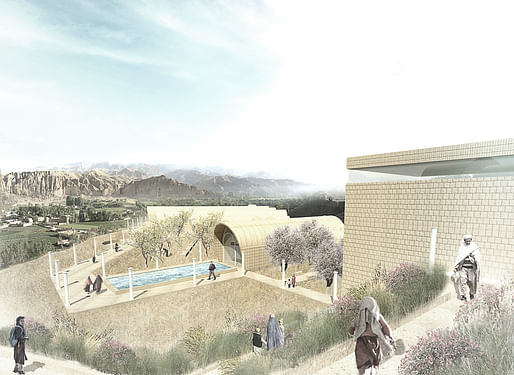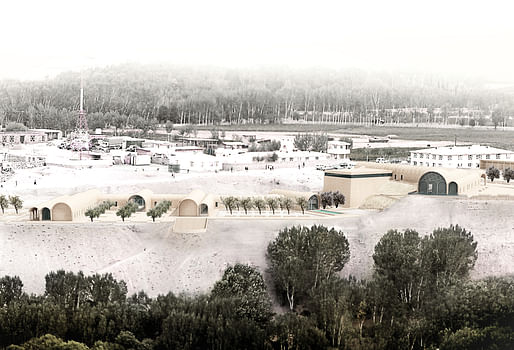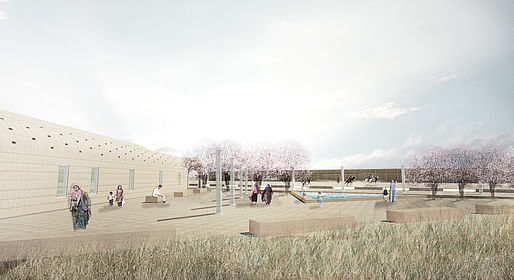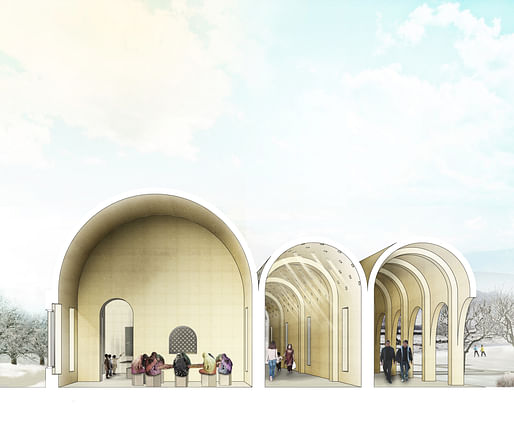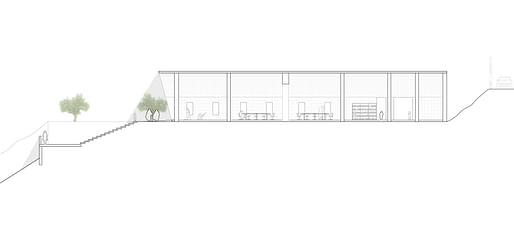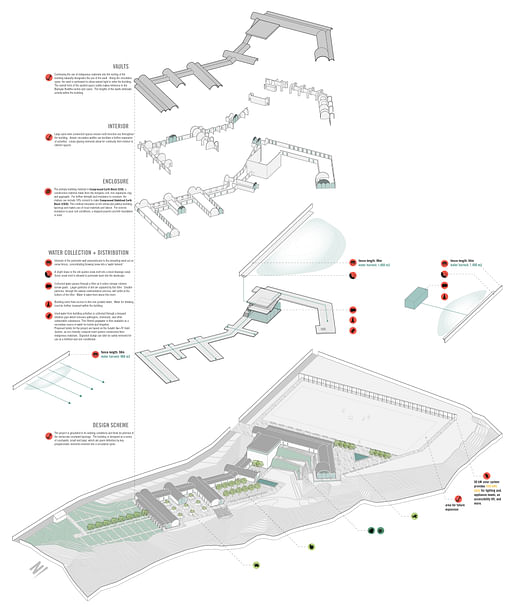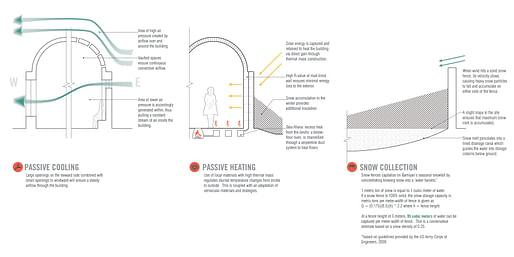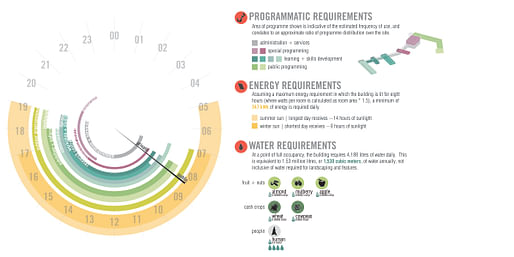
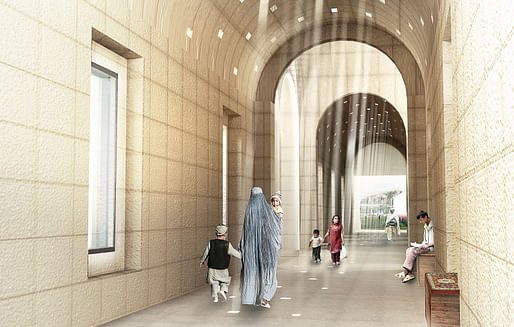
Janna is the root word in Arabic for both Paradise, Jannah, and for gardens, Jannat. The Cultural Centre for Bamiyan finds its premise here, envisioned as a pause in the expansive landscape, and a catalytic hub for the community. Design of the Centre is a considered approach of two parts; the concept of Jannat garden courtyards which serve as an organizing morphology, and embedded infrastructure resource issues unique to the site, including the integration and adaptation of local building technologies and harvesting snow and solar energy, which cultivate holistic practices toward a sustainable future.
The spaces of the Centre are a series of unfolding garden courtyards, each with its own edible arboreal themes. The complex is flanked with a lively sports and recreational field on one end, and educational micro-farming plots on the other. The organization of the complex also acts as a spatial hub, with a shift in the geometry of the layout to frame sequential vistas of the Buddha cliffs and landscape beyond. The Centre is a dynamic place of learning and promotes the exchange of knowledge at all scales, planned or impromptu, ensuring programme adaptability that serves multiple functions. Programme distribution extends over the length of the site, with principal public spaces situated on the upper plateau. Public permeability exists through the entirety of the building; a multi-purpose perforated circulation spine runs the length of the building, intersected and expanded by key programmatic elements which interact with and begin to define exterior courtyards.
The aggregate framing of spaces surrounded by the Jannat gardens is the design compositional approach, with a focus on creating a series of community scaled spaces. Such spaces facilitate multiple uses and allow for the continuous integration of the context through ample views to the Buddha cliffs, landscape, and immediate edible gardens. Plantings within the gardens create a distinct tangibility between user and landscape, and are conducive and native to Bamiyan climactic conditions. These plantings also begin to introduce crop diversification, which can further be experimented with in the micro-farming fields. Accordingly, each garden courtyard space has a distinct theme of activity and arbor and can sufficiently appeal and cater to needs and interests for all demographics. The Jannat gardens thus create a series of unique microclimates that encompass the Cultural Centre and foster an appreciation for diversity through learning, innovation, and engagement between ideas, people, and local context.
This synergy extends beyond the conceptual organization of the building. The Bamiyan Cultural Centre speaks to Afghanistan’s resource issues, with a specific focus on infrastructure embedded within architecture. The Centre is self-sufficient, capitalizing on the availability of solar energy, as well as Bamiyan’s significant annual snowfall. Annual electricity requirements are maintained by way of a 50 kW solar panel system which doubles as a shaded viewing pavilion to the south of the recreation field. Yearly water requirements are met through a snow fence system which is integrated as a secondary function of the perimeter wall. Water is collected, filtered, and stored for use throughout the year, and eventually cycles back into the landscape.
The building system is Compressed Earth Block (CEB), a material composed of local components including dry soil, clay, and aggregate, with the supplemental addition of 10% cement to create a strong and durable material, Compressed Stabilized Earth Block (CSEB). This material resists moisture and has significant thermal qualities that will delay the effect of external temperatures on interior spaces. That is, the thermal mass of the material will regulate the diurnal temperature range, cooling spaces in the summer, and warming them in the winter, efficiently retaining heat. Moreover, CSEB is sustainable in its resourcing (excavated material will be a prime ingredient) and importantly, in the fabrication and construction which will employ and empower local inhabitants of Bamiyan. The material is resilient, and through the construction of the Centre, will inspire an innovative development of local approaches to building construction.
By utilizing local materials, complimented with inventive building technologies that capitalize on existing conditions, the Bamiyan Cultural Centre articulates directly an intrinsic notion of sustainable and regenerative living. Not only will the Centre be economical in its construction, it will utilize financial resources to empower local inhabitants to learn, manufacture, and construct the centre. Simultaneously the Centre will focus on an investment in a landscape of edible gardens that can become incubators not only of food production, but of didactic methods for self-reliance in the community.
The Bamiyan Cultural Centre can truly manifest itself as a Janna, an inspirational and influential hub for the community that revitalizes the contextual landscape, and empowers the people with skill-building activities and cultural exchange. The Centre is an architecture that arises from enduring social, physical, and tectonic conditions, and reinforces Bamiyan’s position as a place of exchange, knowledge, and production. Accordingly, the Centre will underscore the pride the community has in its distinct local heritage, as well as its national identity. In its ability to foster human potential and capacity building, the Bamiyan Cultural Centre truly becomes a thriving space for civil society.
Status: Competition Entry